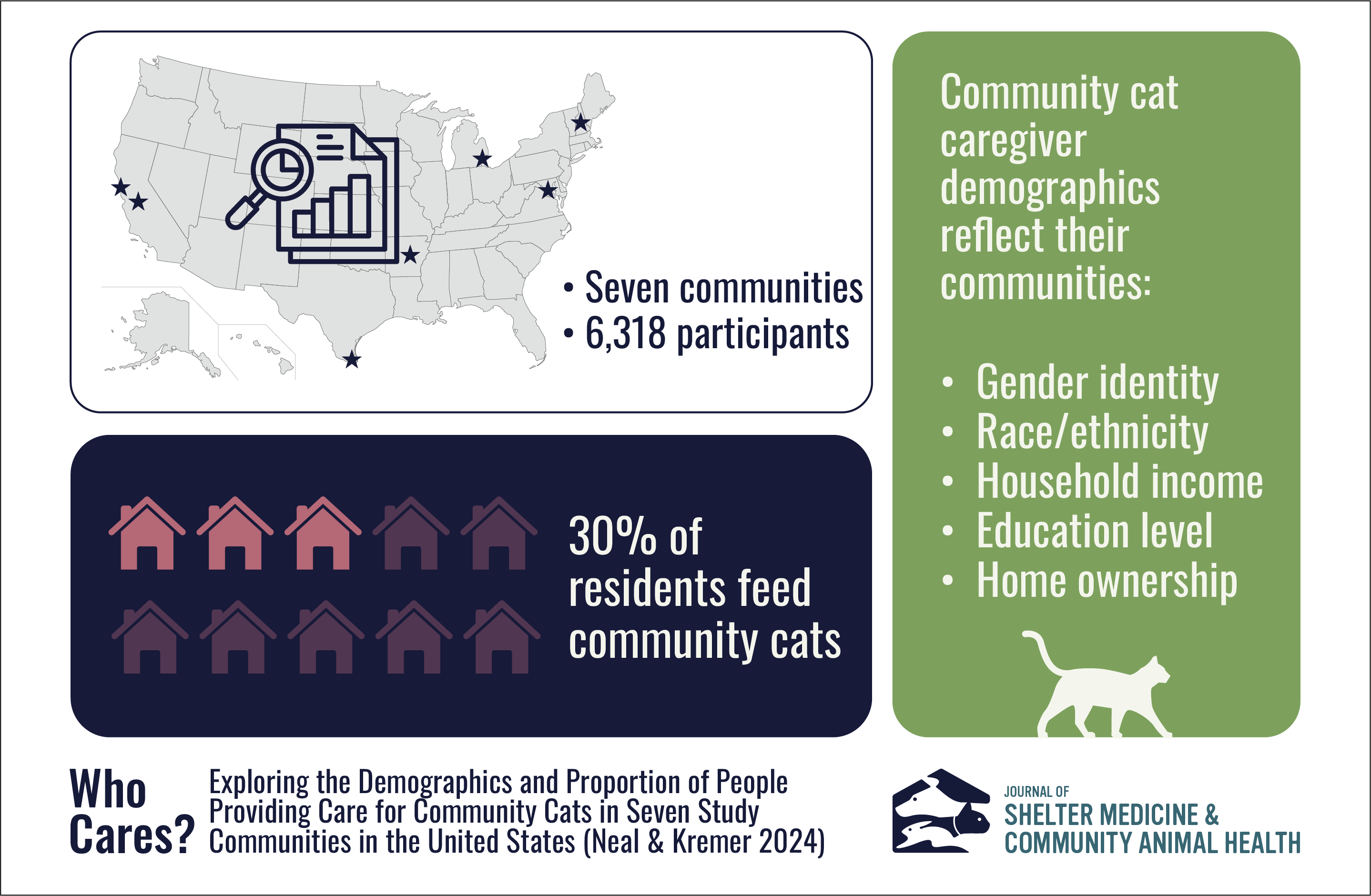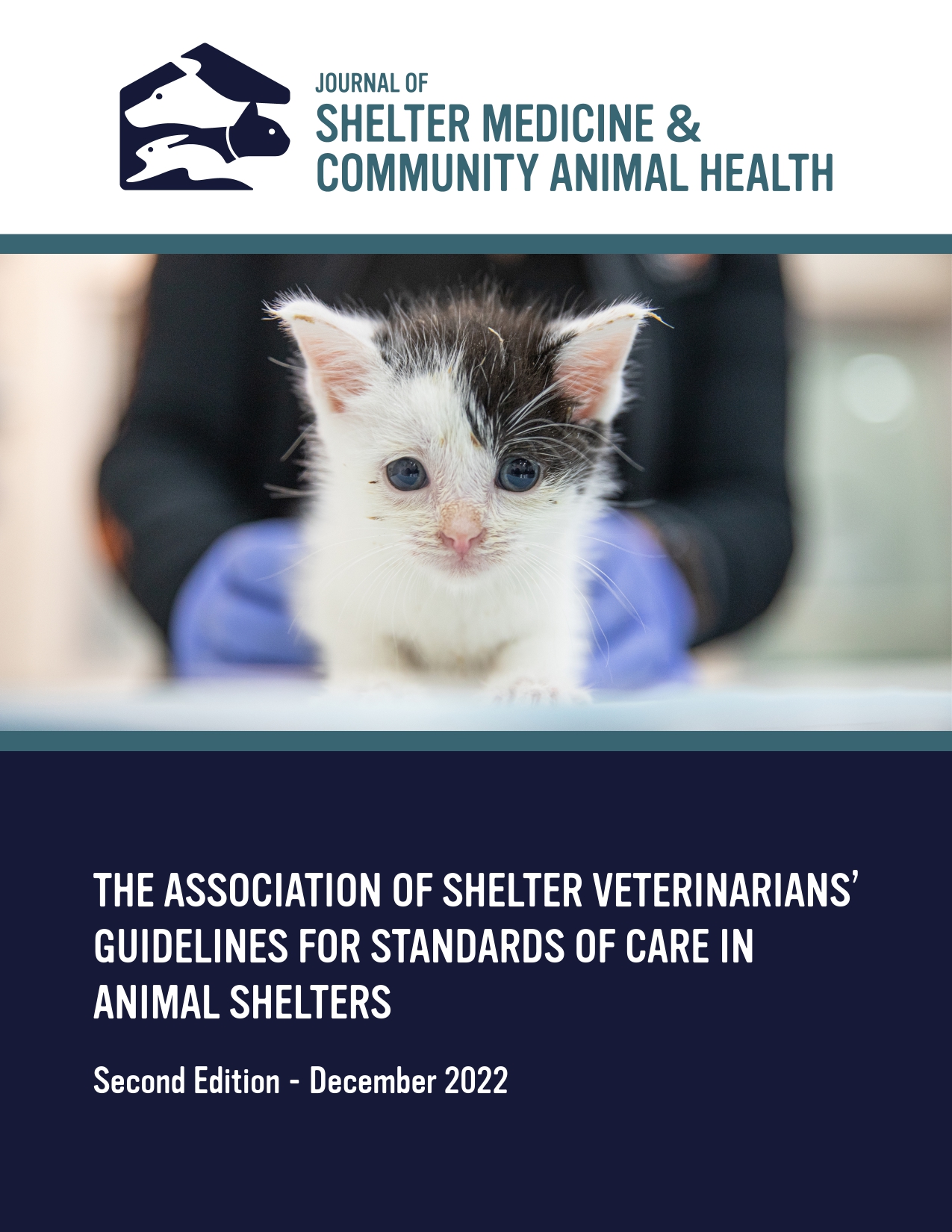Who Cares? Exploring the Demographics and Proportion of People Providing Care for Community Cats in Seven Study Communities in the United States
DOI:
https://doi.org/10.56771/jsmcah.v3.71Keywords:
community cat, feral cat, feeding cats, DEIAbstract
Introduction: While several studies have evaluated the demographics of pet ownership in the US, few studies have explored the demographics and proportion of the population that feed community cats. This research examines these questions in seven geographically diverse study communities. The concept of capacity for caring is advanced as a way to quantify a community’s ability and willingness to provide for community cats.
Methods: A web-based panel survey was distributed and received 6,318 responses. The survey was administered in seven different study communities as part of a larger survey. Individuals were asked a series of demographic and socioeconomic questions as well as whether they fed community cats.
Results: The profile of people feeding community cats is diverse with Black and Hispanic respondents emerging as more likely to feed cats than White respondents. Results indicate that an average of 30% of people feed community cats, and that most feed three or fewer cats. Significant variation in the proportion of people feeding cats is seen across the seven study communities, perhaps driven by the number of cats in the different communities. Confirming findings of previous studies, individuals who have pets of their own are also significantly more likely to feed community cats.
Conclusion: The results indicate that communities have a relatively high capacity to care for community cats. This research also adds an equity perspective to programs aimed at removal of community cats from their spaces. Cat caregivers are diverse and generally reflect their respective communities. Policymakers should consider the impact to the cats and their caregivers before implementing programs that target removal of community cats from their outdoor homes.
Downloads
References
Shelter Animals Count. Industry Trends Dashboard. https://www.shelteranimalscount.org/industry-trends-dashboard/. Accessed January 25, 2024.
Neal SM, Wolf PJ. A cat is a cat: attachment to community cats transcends ownership status. J Shelter Med Community Anim Health. 2023;2(1). doi: 10.56771/jsmcah.v2.62
Scotney R, Rand J, Rohlf V, Hayward A, Bennett P. The impact of lethal, enforcement-centred cat management on human well-being: exploring lived experiences of cat carers affected by cat culling at the Port of Newcastle. Animals. 2023;13(2):271. doi: 10.3390/ani13020271
Levy JK, Woods JE, Turick SL, Etheridge DL. Number of unowned free-roaming cats in a college community in the southern United States and characteristics of community residents who feed them. J Am Vet Med Assoc. 2003;223(2):202–205. doi: 10.2460/javma.2003.223.202
Kass PH, Johnson KL, Weng HY. Evaluation of animal control measures on pet demographics in Santa Clara County, California, 1993–2006. PeerJ. 2013;1:e18. doi: 10.7717/peerj.18
Lord LK. Attitudes toward and perceptions of free-roaming cats among individuals living in Ohio. J Am Vet Med Assoc. 2008;232(8):1159–1167. doi: 10.2460/javma.232.8.1159
Levy JK, Isaza NM, Scott KC. Effect of high-impact targeted trap-neuter-return and adoption of community cats on cat intake to a shelter. Vet J. 2014;201(3):269–274. doi: 10.1016/j.tvjl.2014.05.001
American Pet Products Association. The 2017–2018 APPA National Pet Owners Survey. Greenwich, CT: American Pet Products Manufacturers Association; 2019.
American Pet Products Association. The 2019–2020 APPA National Pet Owners Survey: cats for all ages. https://americanpetproducts.org/Uploads/MemServices/Cat_2-19-20.jpg. Accessed March 23, 2023.
Zasloff LR, Hart LA. Attitudes and care practices of cat caretakers in Hawaii. Anthrozoös. 1998;11(4):242–248. doi: 10.2752/089279398787000599
Neumann SL. Animal welfare volunteers: who are they and why do they do what they do? Anthrozoös. 2010;23(4):351–364. doi: 10.2752/175303710X12750451259372
Loss SR, Marra PP. Merchants of doubt in the free-ranging cat conflict. Conserv Biol. 2018;32(2):265–266. doi: 10.1111/cobi.13085
McCubbin SG, Van Patter LE. Trophy hunters & crazy cat ladies: exploring cats and conservation in North America and Southern Africa through intersectionality. Gend Place Cult. 2021;28(9):1327–1350. doi: 10.1080/0966369X.2020.1791802
Human Animal Support Services. HASS. https://www.humananimalsupportservices.org/. Accessed January 25, 2024.
2020 Standards for Delineating Core Based Statistical Areas. Federal Register; 2021. https://www.federalregister.gov/documents/2021/07/16/2021-15159/2020-standards-for-delineating-core-based-statistical-areas. Accessed March 15, 2024.
U.S. Census Bureau QuickFacts: United States. https://www.census.gov/quickfacts/fact/table/US/PST045222. Accessed October 5, 2023.
Stellar JE, Manzo VM, Kraus MW, Keltner D. Class and compassion: socioeconomic factors predict responses to suffering. Emot Wash DC. 2012;12(3):449–459. doi: 10.1037/a0026508
Van Patter L, Flockhart T, Coe J, et al. Perceptions of community cats and preferences for their management in Guelph, Ontario. Part II: a qualitative analysis. Can Vet J. 2019;60(1):48–54.

Published
Issue
Section
License
Copyright (c) 2024 Sue M. Neal, Tom Kremer

This work is licensed under a Creative Commons Attribution 4.0 International License.









